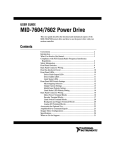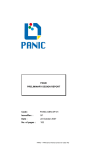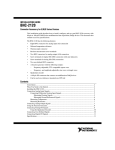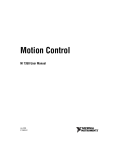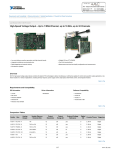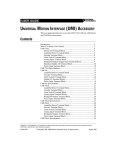Download MID-7604/7602 POWER DRIVE User Guide - Index of
Transcript
USER GUIDE MID-7604/7602 POWER DRIVE This user guide describes the electrical and mechanical aspects of the MID-7604/7602 power drive and describes how to use the MID-7604/7602 with your motion controller. Contents Conventions ............................................................................................ 2 Introduction ............................................................................................. 2 What You Need to Get Started ............................................................... 3 Safety Information .................................................................................. 3 Installation and Connector Wiring.......................................................... 4 Front Panel Switches............................................................................... 5 Host Bus Interlock Circuit ...................................................................... 6 Front Panel LEDs.................................................................................... 6 Driver Fault Output LEDs ............................................................... 6 Driver Inhibit LEDs ......................................................................... 7 Limit Status LEDs ........................................................................... 7 Front Panel DIP Switch Settings............................................................. 7 Microstepping Selection .................................................................. 8 Output Current Settings ................................................................... 9 Inhibit Input Polarity Setting ........................................................... 10 Limit Status LED Polarity Setting ................................................... 10 Back Panel Connector Wiring................................................................. 11 Motor Power Terminal Blocks ........................................................ 11 Encoder Terminal Blocks ................................................................ 12 Limit Switch Terminal Blocks......................................................... 15 Breakpoint and Trigger Terminal Blocks ........................................ 15 Analog I/O Terminal Blocks............................................................ 16 Amplifier/Driver Command Signals....................................................... 17 Stepper Motor Configurations ................................................................ 17 Specifications .......................................................................................... 20 Support Information................................................................................ 24 National Instruments ™ and ni.com ™ are trademarks of National Instruments Corporation. Product and company names mentioned herein are trademarks or trade names of their respective companies. 322454B-01 © Copyright 1999 National Instruments Corp. All rights reserved. December 1999 Conventions The following conventions are used in this manual: This icon denotes a note, which alerts you to important information. This icon denotes a caution, which advises you of precautions to take to avoid injury, data loss, or a system crash. This icon denotes a warning, which advises you of precautions to take to avoid being electrically shocked. italic Italic text denotes emphasis, a cross reference, or an introduction to a key concept. This font also denotes text that is a placeholder for a word or value that you must supply. overline Indicates the signal is active-low. Introduction Your MID-7604/7602 power drive is a complete power amplifier and system interface for use with four or two axes of simultaneous stepper motion control. Ideally suited to industrial and laboratory applications, the MID-7604/7602 has everything you need to connect motors, encoders, limit switches, I/O, and other motion hardware to National Instruments motion controllers. The MID-7604/7602 can drive a broad range of stepper motors with its rugged microstepping bipolar chopper driver and user-selectable current-per-phase settings. In all configurations, power supplies are built in and use standard 240/120 VAC for operation. Electronics are fan cooled to assure reliable operation. The MID-7604/7602 simplifies your field wiring through separate encoder, limit switch, and motor power removable screw terminal connector blocks for each axis. The terminal blocks do not require any special wiring tools for installation. The MID-7604/7602 connects to National Instruments motion controllers via a 68-pin, high-density interconnect cable. The MID-7604/7602 has four levels of amplifier inhibit/disable protection for motion system shut down. The front panel contains both enable and power switches for direct motor inhibiting and system power-down operations. The MID-7604/7602 also has a host bus power interlock that activates an internal driver inhibit signal if the host computer is shut down or the motion controller interface cable is disconnected. The inhibit input MID-7604/7602 Power Drive 2 www.ni.com from the back panel connectors also inhibits the stepper drives when activated. The MID-7604/7602 is packaged in a rugged, lightweight enclosure that can be used as a benchtop unit or that can be rack-mounted using a 19-in. standard rack kit. What You Need to Get Started To set up and use your MID-7604/7602 accessory, you must have the following items: ❑ The MID-7604/7602 accessory and MID-7604/7602 Power Drive User Guide ❑ Power cord (IEC type) ❑ One of the following shielded cable assemblies, as applicable: • SH68-C68-S, part number 186381-02 • SHC68-C68-S, part number 186380-02 Refer to the Specifications section later in this guide for detailed specifications for the MID-7604/7602. Safety Information Warnings Keep away from live circuits. Do not remove equipment covers or shields unless you are trained to do so. Hazardous voltages may exist even when the equipment is turned off. To avoid a shock hazard, do not perform procedures involving cover or shield removal unless you are qualified to do so and disconnect all field power prior to removing covers or shields. Do not operate damaged equipment. The safety protection features built into this device can become impaired if the device becomes damaged in any way. If the device is damaged, turn the device off and do not use it until service-trained personnel can check its safety. If necessary, return the device to National Instruments for service and repair to ensure that its safety is not compromised. Do not operate this equipment in a manner that contradicts the information specified in this document. Misuse of this equipment could result in a shock hazard. Do not substitute parts or modify equipment. Because of the danger of introducing additional hazards, do not install unauthorized parts or modify the device. Return the device to National Instruments for service and repair to ensure that its safety features are not compromised. © National Instruments Corporation 3 MID-7604/7602 Power Drive When connecting or disconnecting signal lines to the MID-7604/7602 terminal block screw terminals, make sure the lines are powered off. Potential differences between the lines and the MID-7604/7602 ground create a shock hazard while you connect the lines. Connections, including power signals to ground and vice versa, that exceed any of the maximum signal ratings on the MID-7604/7602 device can create a shock or fire hazard or can damage any or all of the motion controllers connected to the MID-7604/7602 chassis, the host computer, and the MID-7604/7602 device. National Instruments is not liable for any damages or injuries resulting from incorrect signal connections. Installation and Connector Wiring Figure 1 shows connectors located on the back panel of your MID-7604/7602. 7 1 1 2 3 4 5 6 2 3 4 Motion Controller Connector Analog Input Connector Analog Output Connector Trigger Connector Breakpoint Connector AC Power 5 8 9 11 12 Encoder Connectors 7 Axis 1 8 Axis 2 9 Axis 3 10 Axis 4 10 15 13 16 17 18 6 14 Limit Connectors 11 Axis 1 12 Axis 2 13 Axis 3 14 Axis 4 Motor Connectors 15 Axis 1 16 Axis 2 17 Axis 3 18 Axis 4 Figure 1. MID-7604/7602 Back Panel Connectors Caution Be sure to turn off the enable switch and the main AC power to your MID-7604/7602 and host computer before connecting the accessory to your motion controller. Connect the motion controller to the MID-7604/7602 with the interface cable. Wire the motor power, limit switch, encoder, and I/O terminal blocks as described in this document and to your specific system requirements. Use the LINE VOLTAGE SELECT switch to configure the MID-7604/7602 for 120 VAC, 60 Hz or 240 VAC, 50 Hz operation. For proper operation, you must set this switch to match your power source. You must change the MID-7604/7602 main input fuse on the front panel if you change the line voltage from the factory setting. Refer to the Specifications section of this document for fuse specifications. Warning MID-7604/7602 Power Drive 4 www.ni.com Finally, install the power cord into the back panel AC connector and plug it into a correctly rated power source. Front Panel Switches Figure 2 shows the front panel for your MID-7604/7602. The DIP switches are shown with the detachable metal cover plate removed. AXIS CONFIGURATION LINE VOLTAGE SELECT AC POWER FUSE ENABLE FAULTS INHIBITS ON ON 1 1 2 3 4 2 OFF 3 ON ON LIMITS 1 +5V ON 4 Main Input Fuse Line Voltage Select Switch Power Switch Green Power LED ON OFF 5 5 6 7 6 7 Enable Switch Axis 1 DIP Switch Bank Axis 2 DIP Switch Bank 8 9 2 3 AXIS 4 10 8 Axis 3 DIP Switch Bank 9 Axis 4 DIP Switch Bank 10 LED Status Array Figure 2. MID-7604/7602 Front Panel There are two rocker switches on the MID-7604/7602 front panel: AC POWER and ENABLE. Refer to Figure 2 for the location of these switches. The AC POWER switch energizes the motor bus (+24 V) and the logic (+5 V) power supplies. When switched on, the green power LED labelled +5 V illuminates. If this LED fails to illuminate, check the power cord and main input fuse on the front panel. The ENABLE switch enables or inhibits the stepper drivers. If the ENABLE switch is in the inhibit position (OFF), the stepper drivers are inhibited and the yellow LEDs, the middle row of the LED status array, for all axes illuminate. See the Front Panel LEDs section of this document for more information. Both the AC POWER and ENABLE switches can inhibit the stepper drivers. However, as long as the AC POWER switch is on, only the stepper driver output stages are disabled. The remaining circuitry remains active, including the quadrature encoder circuit. You must change the MID-7604/7602 main input fuse on the front panel if you change the line voltage from the factory setting. Refer to the Specifications section of this document for fuse specifications. Warning © National Instruments Corporation 5 MID-7604/7602 Power Drive Host Bus Interlock Circuit The MID-7604/7602 has a host bus interlock circuit that monitors the presence of +5 V from the host computer and disables the MID-7604/7602 when the voltage is not present or falls out of tolerance. This circuit shuts down the stepper drives for all axes by activating the inhibit when the host computer is disconnected from the MID-7604/7602 or inadvertently shut down. Activation of the host bus interlock circuitry illuminates the yellow LEDs (middle row) of the LED status array for all axes. See the Front Panel LEDs section of this document for more information. Front Panel LEDs The front panel LEDs consist of a single green LED to indicate if the main power is active and an LED status array of 3 rows by 4 columns that provides a variety of status information. Refer to Figure 2 for the location of the front panel LEDs. If the DC power supplies are active, the green power LED illuminates. If this LED fails to illuminate, check the power cord and the main input fuse on the front panel. The LED status array is arranged by motor axes. Each of the four columns represents an axis, and each of the three rows represents a particular status. Table 1 summarizes the axes and statuses to which the different LEDs in the 3 × 4 array correspond. Table 1. Front Panel LED Indicators Status Motor Axis Driver Fault Output (red) 1 2 3 4 Driver Inhibit (yellow) 1 2 3 4 Limit Status (green) 1 2 3 4 Driver Fault Output LEDs The top row of LEDs indicates the status of the stepper drivers. When an LED illuminates red, there is either an overcurrent condition or a problem with the motor bus voltage on that axis. MID-7604/7602 Power Drive 6 www.ni.com Driver Inhibit LEDs The middle row of LEDs indicates if a motor axis is inhibited. An axis is inhibited and the LED illuminates yellow if the host bus interlock circuitry is activated from the back panel, if the ENABLE switch on the front panel is in the inhibit position, if the motion controller’s inhibit signal is low, or if the per-axis inhibit input is actively driven. The polarity of the per-axis inhibit input is selectable from the front panel DIP switches. See the Front Panel DIP Switch Settings section of this document for more information. Limit Status LEDs The bottom row of LEDs indicates if a limit switch is currently active. The LED illuminates green if either the forward or reverse limit switch is active for each axis. You can select the polarity for the limit status LEDs from the front panel DIP switches. See the Front Panel DIP Switch Settings of this document for more information. Front Panel DIP Switch Settings The MID-7604/7602 front panel has a detachable metal plate that, when removed, provides access to four 10-position DIP switch banks. Refer to Figure 2 for the location of these switches. Use the first nine DIP switches on each 10-position DIP switch bank to configure the microstep rate, peak output current, and current reduction for each axis. The DIP switch banks for axes 1 and 2 contain a global DIP switch, switch 10, which sets the polarity of the inhibit input and the polarity of the limit status LED, respectively. 1 O 1 N 2 2 3 4 5 6 7 8 9 10 3 1 2 3 Peak Current Output Switches Microstep Rate Switches Current Reduction Switch 4 4 Global Polarity Switch (unused on axes 3 and 4 DIP switch banks) Figure 3. DIP Switch Bank Layout © National Instruments Corporation 7 MID-7604/7602 Power Drive Microstepping Selection The MID-7604/7602 uses bipolar chopper, two-phase microstepping drivers with a broad range of microstep rates. The factory-default setting is 10-times microstepping (2,000 steps/rev with standard 1.8º stepper motors). Table 2 shows the DIP switch settings for all possible microstep settings. DIP switches 6 through 9 control the microstep rate on a per-axis basis. Table 2. Microstep Rate DIP Switch Setting Binary Selections Switch Decimal Selections Microsteps/Step Switch 2 (half step) O N 6 7 8 9 4 O N O N 6 7 8 9 6 7 8 9 8 O N 6 7 8 9 16 6 7 8 9 32 6 7 8 9 64 6 7 8 9 128 6 7 8 9 256 Do not use O N 6 7 8 9 6 7 8 9 MID-7604/7602 Power Drive Do not use O N 6 7 8 9 O N 250 O N 6 7 8 9 O N 125 O N 6 7 8 9 O N 50 O N 6 7 8 9 O N 10 (factory default) 25 O N 6 7 8 9 O N 5 O N 6 7 8 9 Microsteps/Step 8 www.ni.com Output Current Settings The MID-7604/7602 can provide 0.20–1.4 A peak (0.14–1 A RMS) depending on the peak output current DIP switch settings for each axis. DIP switches 1 through 4 control the peak output current. Table 3 shows the DIP switch settings for all possible peak output current settings. Table 3. Peak Output Current DIP Switch Setting Switch Peak Output (A) Switch 1.40 O N 1 2 3 4 1.20 O N 1 2 3 4 1.00 O N 0.28 O N 1 2 3 4 1 2 3 4 0.85 O N 0.27 O N 1 2 3 4 1 2 3 4 0.70 O N 0.25 O N 1 2 3 4 1 2 3 4 0.60 O N 0.24 O N 1 2 3 4 1 2 3 4 0.55 O N 0.23 O N 1 2 3 4 1 2 3 4 0.30 O N 1 2 3 4 O N 0.35 O N 1 2 3 4 Peak Output (A) 1 2 3 4 0.50 (factory default) 0.20 O N 1 2 3 4 You can configure the MID-7604/7602 stepper drivers in a current reduction mode on a per-axis basis. This is useful to minimize motor heating when you are not stepping. When current reduction is enabled, the current decreases by 50% when no stepping has occurred for approximately 500 ms. DIP switch 5 controls current reduction on a per-axis basis. When this DIP switch is on, current reduction is enabled. When this DIP switch is off, current reduction is disabled. The factory default setting is current reduction enabled. © National Instruments Corporation 9 MID-7604/7602 Power Drive Table 4 shows the available settings for DIP switch 5. Table 4. Current Reduction DIP Switch Settings Switch Setting Operation Current reduction enabled (factory default) O N 5 Current reduction disabled O N 5 Inhibit Input Polarity Setting The MID-7604/7602 has a DIP switch that globally sets the polarity for the inhibit input for all axes. DIP switch 10 on the axis 1 DIP switch bank controls this setting. Refer to Figures 2 and 3 for the location of this switch. The factory-default setting of DIP switch 10 is active-low. If the inhibit input is active, the axis is inhibited and the yellow status LED (middle row) illuminates for the axis. Table 5 shows the DIP switch setting for the inhibit input polarity selection. Table 5. Inhibit Input Polarity DIP Switch Settings Axis 1 Switch Setting Operation Active-high O N 10 Active-low (factory default) O N 10 Limit Status LED Polarity Setting The MID-7604/7602 has a DIP switch that globally sets the polarity for the Limit Status LED. DIP switch 10 on the axis 2 DIP switch bank controls this setting. Refer to Figures 2 and 3 for the location of this switch. The factory-default setting is active-low. Typically, you set the switch to match your controller’s polarity setting, so that if either the reverse or forward limits for an axis are active, the green status LED (on the bottom row) for the axis illuminates. This DIP switch alters only the polarity for the LEDs, not the actual limit to the motion controller. Table 6 shows the DIP switch setting for the Limit Status LED polarity selection. MID-7604/7602 Power Drive 10 www.ni.com Table 6. Limit Status LED DIP Switch Settings Axis 2 Switch Setting Operation Active-high O N 10 Active-low (factory default) O N 10 Back Panel Connector Wiring Motor Power Terminal Blocks For motor power wiring, each MID-7604/7602 axis has a separate 5-position removable screw terminal block. Figure 4 shows a typical stepper motor configuration pin assignment. Note The dotted loop indicates a shielded cable. A lin e above a signal indicates that the signal is active-low. Phase A Phase A Case Ground Phase B Phase B Stepper Motor 1 2 3 4 5 Shield Figure 4. Typical Full-Coil Stepper Motor (2-Phase Type) Terminal Block Pin Assignment Use shielded, 20 AWG wire or larger for the motor power cable. If available, you should connect a case ground wire to pin 3 (Ground/Shield); this helps to avoid ground loops and signal noise problems. Case ground connects to the motor housing, and not to any of the motor power terminals. The MID-7604/7602 contains bipolar chopper drivers. You must wire the stepper motors in a 4-wire configuration as shown in Figure 4. You must isolate unused lead wires and leave them disconnected. See the Stepper © National Instruments Corporation 11 MID-7604/7602 Power Drive Motor Configurations section in this document for additional information on connecting 6- and 8-wire motors and on the alternate half-coil configuration. Caution Never connect unused center taps or winding terminals to pin 3 (ground) or each other. Encoder Terminal Blocks For quadrature incremental encoder signals, each MID-7604/7602 axis has a separate 8-position removable screw terminal block. Where applicable, the MID-7604/7602 accepts two types of encoder signal inputs: single-ended (TTL) or differential line driver. You can accommodate open-collector output encoders by using 2.2 kΩ pullup resistors to +5 VDC. Figure 5 shows the typical encoder wiring pin assignment for single-ended signal input. Encoder A Encoder B Encoder Index +5 V Digital Ground 1 2 3 4 5 6 7 8 Figure 5. Typical Single-Ended Encoder Wiring Pin Assignment Figure 6 shows the typical encoder wiring pin assignment for differential line driver signal inputs. Encoder A Encoder A Encoder B Encoder B Encoder Index Encoder Index +5 V Digital Ground 1 2 3 4 5 6 7 8 Figure 6. Typical Differential Line Driver Encoder Wiring Pin Assignment MID-7604/7602 Power Drive 12 www.ni.com If the encoder cable length is greater than 10 ft, use encoders with line driver outputs for your applications. Power for a +5 V encoder—generated by a power supply inside the MID-7604/7602—is available on pin 7. Note If you require other encoder power voltages, reference an external power supply to the Digital Ground signal on the 8-pin encoder terminal block. The MID-7604/7602 supports differential inputs for Phase A, Phase B, and Index signals. You can easily accommodate encoders with various phase relationships by swapping the signals and/or connecting them to the inverting inputs as specific applications require. The Index signal must occur when both Phase A and Phase B signals are low, as shown in Figure 7. If the Index polarity is inverted, try reversing the Index and Index signals on differential encoders or using the Index input on single-ended encoders. Figure 7 shows the proper encoder phasing for CW (forward) motor rotation. Phase A Phase B Index Figure 7. Encoder Signal Phasing, CW Rotation Closed-loop stepper applications require consistent directional polarity between the motor and encoder for correct operation. The National Instruments motion control standard directional polarity is as follows: • Positive = forward = clockwise (CW) facing motor shaft • Negative = reverse = counter-clockwise (CCW) facing motor shaft © National Instruments Corporation 13 MID-7604/7602 Power Drive Figure 8 shows clockwise and counter-clockwise motor rotation. W C W C C Figure 8. Clockwise and Counter-Clockwise Motor Rotation When connecting the encoder wiring to your MID-7604/7602, use shielded wire of at least 24 AWG. Analog noise filters filter the encoder inputs in the MID-7604/7602. You must use cables with twisted pairs and an overall shield for improved noise immunity and enhanced encoder signal integrity. Figure 9 shows twisted pairs in a shielded cable. Drain Shield Encoder A Encoder A Encoder B Encoder B Encoder Index Encoder Index +5 V Digital Ground Figure 9. Shielded Twisted Pairs Note If you use an unshielded cable, noise can corrupt the encoder signals, resulting in lost counts, reduced accuracy, and other erroneous encoder and controller operation. MID-7604/7602 Power Drive 14 www.ni.com Limit Switch Terminal Blocks For end-of-travel limit, home, inhibit input, and inhibit output connections, MID-7604/7602 axes have a separate, 6-position removable screw terminal connector block. Figure 10 shows the limit switch terminal block pin assignments. Forward Limit Home Input Reverse Limit Inhibit Input Inhibit Output Digital Ground 1 2 3 4 5 6 Figure 10. Limit Switch Terminal Block Pin Assignment (Passive Limit Switch Connection Example) The inhibit output signal is asserted low from the MID-7604/7602 when an axis is inhibited. This signal can be useful for actuating mechanical brakes or for monitoring an axis status. An axis is inhibited if the host bus interlock circuitry is activated, if the ENABLE switch on the front panel is in the inhibit position, if the motion controller’s inhibit signal is low, or if the per-axis inhibit input is actively driven. The MID-7604/7602 stepper drive remains in a reset state for 500 ms after the inhibit is deasserted. Therefore, you can lose steps if you attempt to issue a start motion command within 500 ms from the deassertion of the stepper drive inhibit. A Kill command asserts the inhibit signal from the controller and a Halt command deasserts the inhibit signal from the controller. The yellow LEDs (middle row) on the front panel illuminate if an axis is currently inhibited (killed state). You should execute a halt stop to deassert the inhibit signal from the controller, after which you must wait at least 500 ms before executing a start. Breakpoint and Trigger Terminal Blocks Both the breakpoint and trigger connectors use a 6-pin removable terminal block. The trigger terminal block provides access to the trigger input lines, shutdown input line, and digital ground. The breakpoint terminal block provides access to the breakpoint output lines, +5 V supplied by the MID-7604/7602, and digital ground. Figures 11 and 12 show the breakpoint and trigger 6-position terminal block assignments. © National Instruments Corporation 15 MID-7604/7602 Power Drive Trigger Input 1 Trigger Input 2 Trigger Input 3 Trigger Input 4 Shutdown Input Digital Ground 1 2 3 4 5 6 Figure 11. Trigger Terminal Block Pin Assignment Breakpoint Output 1 Breakpoint Output 2 Breakpoint Output 3 Breakpoint Output 4 +5 V Digital Ground 1 2 3 4 5 6 Figure 12. Breakpoint Terminal Block Pin Assignment Analog I/O Terminal Blocks There are two analog I/O connectors on the MID-7604/7602. The analog input connector uses a 6-pin removable terminal block and the analog output connector uses a 5-pin removable terminal block. The analog input terminal block provides access to four analog-to-digital converter channels, an analog reference voltage from the converter circuit, and an analog input ground signal. The analog output terminal block provides access to four digital-to-analog converter channels with ±10 V output range and analog output ground. Refer to Figures 13 and 14 for terminal block pin assignments. Analog Input 1 Analog Input 2 Analog Input 3 Analog Input 4 Analog Reference (Output) Analog Input Ground 1 2 3 4 5 6 Figure 13. Analog Input Terminal Block Pin Assignment Analog Output 1 Analog Output 2 Analog Output 3 Analog Output 4 Analog Output Ground 1 2 3 4 5 Figure 14. Analog Output Terminal Block Pin Assignment MID-7604/7602 Power Drive 16 www.ni.com Amplifier/Driver Command Signals For stepper drivers, there are two industry standards for command signals: • Step and Direction signals (MID-7604/7602 standard) • Independent CW and CCW pulses The MID-7604/7602 uses stepper drivers that have active-low step and direction inputs. You must configure the stepper outputs of your motion controller for Step and Direction signals with inverted (active-low) polarity. Stepper Motor Configurations This section describes the various industry-standard winding configurations for stepper motors and shows how to connect them to a MID-7604/7602. The MID-7604/7602 is compatible with all configurations of two-phase stepper motors. The MID-7604/7602 is not compatible with 5-lead unipolar stepper motors or 5-phase stepper motors. Caution 2-phase stepper motors come in 4-, 6-, and 8-wire variations. Figure 15 shows a 6-wire and an 8-wire stepper motor respectively. A 4-wire motor is the same as a 6-wire motor except that the center taps (CT) are not brought out. Phase A Phase A-CT Phase A-CT Phase A Phase A Phase A-CT Phase A-CT Phase A Phase B Phase B Phase B-CT Phase B-CT Phase B-CT Phase B-CT Phase B Phase B 6-wire 8-wire Figure 15. 6-Wire and 8-Wire Stepper Motors © National Instruments Corporation 17 MID-7604/7602 Power Drive For maximum flexibility, you can connect 8-wire stepper motors in either a series or parallel configuration. Connecting the windings in series as shown in Figure 16 produces the most torque per amp, but has the disadvantage of higher inductance and poorer high-speed performance. Phase A Phase A-CT Phase A-CT Phase A Phase B 1 2 3 4 5 Phase B-CT Phase B-CT Motor Case Ground Phase B Phase A Phase A Ground Phase B Phase B Shield Figure 16. Series Stepper Motor Wiring (Higher Torque, Lower Speed) Alternatively, you can wire 8-wire stepper motors in parallel as shown in Figure 17. This configuration produces better high-speed performance but requires more current to produce rated torque. Phase A Phase A-CT Phase A-CT Phase A Phase B 1 2 3 4 5 Phase B-CT Phase B-CT Motor Case Ground Phase B Phase A Phase A Ground Phase B Phase B Shield Figure 17. Parallel Stepper Motor Wiring (Higher Speed, Lower Torque) Notice that an 8-wire motor wired in series is virtually identical to a 6-wire motor and typically has the same high-torque but low-speed characteristics. While a parallel configuration is not possible with a 6-wire motor, you can usually obtain high-speed performance with the half-coil connection shown in Figure 18. This configuration sacrifices low-speed torque for better high-speed performance. With this configuration, it is typically not possible MID-7604/7602 Power Drive 18 www.ni.com to produce the rated torque of the motor without the risk of the motor overheating because only half of the windings are being used. Phase A Phase A-CT Phase A-CT Phase A Phase B 1 2 3 4 5 Phase B-CT Phase B-CT Motor Case Ground Phase B Phase A Phase A Ground Phase B Phase B Shield Figure 18. Half-Coil Stepper Motor Wiring Figure 19 shows the wiring for a typical 4-wire motor. Phase A Phase A Phase B 1 2 3 4 5 Motor Case Ground Phase B Phase A Phase A Ground Phase B Phase B Shield Figure 19. 4-Wire Motor Wiring © National Instruments Corporation 19 MID-7604/7602 Power Drive Specifications The following specifications apply only to the MID-7604/7602. To obtain a system specification, you must account for your motion controller. Please refer to your controller specifications to determine overall system specifications. Some signals have compatibility defined as signal pass-through. This means the MID-7604/7602 may have passive filtering on these signals but will not affect the voltage range or current handling capability. Consult your motion controller specifications to determine the allowable voltage range and logic level compatibility of the signal. Stepper Drive Amplifier Type ........................................................IM481H modular hybrid, bipolar chopper Chopping frequency ...............................20 kHz Motor bus voltage ...................................24 VDC nominal Current per phase....................................0.20–1.4 A peak (0.14–1 A RMS) (factory setting is 0.50 A peak) Microstepping selections ........................×2, 4, 8, 16, 32, 64, 128, 256 ×5, 10, 25, 50, 125, 250 (factory default is ×10 microsteps/step) Encoder Interface Inputs ......................................................Quadrature, incremental Differential input threshold ....................± 0.3V (typical) Single ended input threshold ..................TTL/CMOS Voltage range..........................................0–5 VDC Noise filter (RC time constant)...............100 ns Maximum quadrature frequency.............1 MHz Limit and Home Switch Inputs Voltage range..........................................0–12 VDC Compatibility ..........................................Signal pass-through MID-7604/7602 Power Drive 20 www.ni.com Inhibit Inputs Voltage range ......................................... 0–12 VDC Noise filter (RC time constant) .............. 10 µs Compatibility ......................................... Signal pass-through Inhibit Output Voltage range ......................................... 0–5 VDC Output low voltage................................. 0.5 V at 64 mA Output high voltage................................ 2.4 V at 32 mA Trigger Input Noise filter (RC time constant) .............. 100 ns Compatibility ......................................... Signal pass-through Breakpoint Output Compatibility ......................................... Signal pass-through Analog Input Noise filter (RC time constant) .............. 10 µs Compatibility ......................................... Signal pass-through Analog Output Compatibility ......................................... Signal pass-through © National Instruments Corporation 21 MID-7604/7602 Power Drive Included Connectors Encoders .................................................8-position mini-combicon 3.81 mm plug (1 per axis) Limits......................................................6-position mini-combicon 3.81 mm plug (1 per axis) Motors.....................................................5-position combicon 5.08 mm plug (1 per axis) Breakpoints .............................................6-position mini-combicon 3.81 mm plug (1 total) Triggers...................................................6-position mini-combicon 3.81 mm plug (1 total) Analog input ...........................................6-position mini-combicon 3.81 mm plug (1 total) Analog output .........................................5-position mini-combicon 3.81 mm plug (1 total) AC power................................................Detachable AC power cord (IEC standard type) Motion I/O ..............................................68-pin female high density VHDCI type Standards Compliance Designed to meet UL Standard for Safety for Power Conversion Equipment, UL 508C, and EN 50178—Electronic equipment for use in power installations Installation Category II, Pollution degree 2 CE compliant to ENC and low-voltage directives Environment Operating temperature ............................0 to 40 ºC (32 to 104 ºF) Storage temperature ................................–20 to 70 ºC (–4 to 158 ºF) Humidity .................................................10% to 90% (noncondensing) MID-7604/7602 Power Drive 22 www.ni.com Power Supply Input voltage .......................................... 90–138 VAC / 204–264 VAC, 47–63 Hz Input fuse 120 VAC (factory default) .............. 6.3 A (Littelfuse #21506.3) 240 VAC ......................................... 4 A (Littelfuse #215004) Input fuse dimensions ............................ 5 × 20 mm Host Bus Voltage Interlock PC bus host voltage threshold ................ 4.5 VDC Physical Length .................................................... 30.7 cm (12.1 in.) Width...................................................... 25.4 cm (10 in.) Height..................................................... 4.3 cm (1.7 in.) Weight .................................................... 4.5 kg (10 lb.) © National Instruments Corporation 23 MID-7604/7602 Power Drive Support Information Worldwide Technical Support and Product Information www.ni.com National Instruments Corporate Headquarters 11500 North Mopac Expressway Austin, Texas 78759-3504 USA Tel: 512 794 0100 Worldwide Offices Australia 03 9879 5166, Austria 0662 45 79 90 0, Belgium 02 757 00 20, Brazil 011 284 5011, Canada (Ontario) 905 785 0085, Canada (Québec) 514 694 8521, China 0755 3904939, Denmark 45 76 26 00, Finland 09 725 725 11, France 01 48 14 24 24, Germany 089 741 31 30, Hong Kong 2645 3186, India 91805275406, Israel 03 6120092, Italy 02 413091, Japan 03 5472 2970, Korea 02 596 7456, Mexico (D.F.) 5 280 7625, Mexico (Monterrey) 8 357 7695, Netherlands 0348 433466, Norway 32 27 73 00, Singapore 2265886, Spain (Madrid) 91 640 0085, Spain (Barcelona) 93 582 0251, Sweden 08 587 895 00, Switzerland 056 200 51 51, Taiwan 02 2377 1200, United Kingdom 01635 523545
























